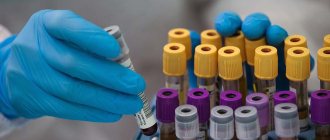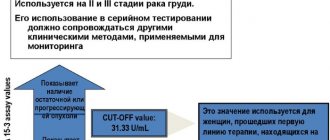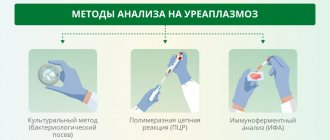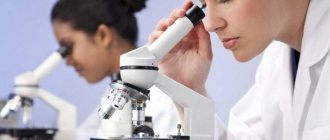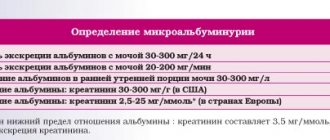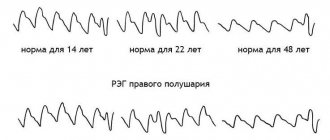Author
Azizov Parviz Faragat Ogly
Leading doctor
Allergist
until September 30
We're giving away RUR 1,000 for all services per visit in September More details All promotions
Immunological blood test
is a laboratory research method that allows you to assess the state of general immunity, its intensity - that is, how much the body’s defense system is involved at the time of analysis, determine the number and function of immune blood cells, and the presence of antibodies in it. Immunological analysis can identify primary and secondary immunodeficiencies and help in the diagnosis of autoimmune, hematological, infectious and lymphoproliferative diseases.
What are antibodies to coronavirus?
Antibodies (also known as immunoglobulins) are special proteins that are produced and/or produced by plasma cells.
What do immunoglobulins do?
Immunoglobulins are formed in response to foreign bacteria or viruses entering the body. They interact with the antigen (specific site of the pest) and neutralize it.
Thus, our immunity guards our health.
What classes of immunoglobulins are there?
There are 5 classes of immunoglobulins, some of which contain subclasses.
IgA - secreted on the surface of the epithelium and present in saliva, tears, and on the surface of mucous membranes.
IgM - detected upon initial exposure to antigen. Indicates an acute infectious process in humans.
IgG is the main class of immunoglobulins that protects against viruses, bacteria, and toxins.
IgD is found on the surface of developing B lymphocytes. The function is not installed.
IgE - secreted during an immediate allergic reaction.
Feces for occult blood (immunochromatographic method)
The presence of blood in stool is not always obvious. However, bleeding during bowel movements is a serious sign that needs to be paid attention to. The cause of bleeding may be damage to the mucous membrane due to intestinal infection, autoimmune diseases, ulcerative colitis, the development of adenomas, cancer and other pathologies that cause its inflammation.
With chronic blood loss, anemia occurs, which most often manifests itself:
- severe weakness and fatigue;
- pale skin;
- brittle nails and hair;
- loss of appetite;
- weight loss.
The presence of these symptoms is an indication for examining hemoglobin levels and, if a decrease is detected, searching for the causes of blood loss. The most common cause is hidden intestinal bleeding, which can be caused, in particular, by:
- colon polyps (small patchy growths of cells on the wall of the colon);
- Crohn's disease (chronic disease of the gastrointestinal tract);
- ulcerative colitis (a chronic inflammatory and ulcerative disease of the colon mucosa, most often manifested by bloody diarrhea);
- colorectal cancer (malignant tumor of the colon and its appendix).
Colon cancer is one of the most common cancers. In Russia, it is second only to breast cancer in women, and to prostate and lung cancer in men. Colon cancer is also one of the most common causes of death among other cancers. This is explained by the fact that the tumor grows asymptomatically for a long time, increasing in size slowly, as a result of which seeking medical help occurs late. Therefore, it is very important to detect pathology as early as possible. Studies designed to detect precancerous conditions and cancer are carried out:
a) direct visualization methods:
- colonoscopy (examination of the internal state of the colon using an endoscope);
- flexible sigmoidoscopy (examination of the intestine using a long instrument with a camera connected to a monitor);
b) indirect visualization methods:
- CT (computed tomography - a painless and non-contact modern diagnostic method based on the action of X-rays);
- MRI (magnetic resonance imaging - a painless method of examining the human body based on the saturation of body tissues with hydrogen and the characteristics of their magnetic properties);
- capsule endoscopy (a method for examining the gastrointestinal tract through the introduction of a sterile, medical, miniature video capsule);
- barium enema with double contrast (x-ray contrast study of the large intestine using barium sulfate and air);
c) stool examination:
- stool occult blood test;
- DNA test (this test detects DNA mutations and methylation markers (modifications of its molecule without changing the nucleotide sequence itself) isolated from a colon tumor).
Examination of feces for occult blood using the FOB Gold immunochemical method is characterized by increased sensitivity to human hemoglobin compared to the most common method - guaiac test and other chemical methods. Previously used reagents reacted positively not only to human hemoglobin, but also to hemoglobin/myoglobin of animal origin that entered the body with food, to some chemicals contained in foods, and to vitamins. All this led to the need to carefully follow the diet on the eve of the study. The use of a new immunochemical method for determining occult blood in feces makes it possible to accurately identify human hemoglobin and does not require dieting before collecting biomaterial.
As part of the immunochemical method for detecting blood in stool, the study of antibodies to human hemoglobin and globin, which are not involved in any processes, is used. This makes the test much more sensitive and allows you to detect hidden bleeding in the colon and rectum. In this case, there is absolutely no reaction to bleeding in the upper gastrointestinal tract, in which the protein part of hemoglobin is digested. Oncology of the colon and rectum is the most common of all malignant neoplasms leading to death. With early diagnosis, the chances of survival are greatly increased. An initial examination to detect hidden bleeding in combination with colonoscopy (if the test result is positive) can prolong the life of 25% of patients. After 50 years (or 40-45 years, if there is a hereditary predisposition to the disease), it is recommended to be examined at least once a year. Since in the initial stage, when the tumor has not yet spread beyond the mucous membrane, a one-time examination may not show its presence, 2-3 single stool tests will be more informative.
This test is designed to detect hidden bleeding in the lower intestine only. It is also used as an initial test in the diagnosis of colorectal cancer. Testing does not indicate the location of the bleeding or its cause, but only states the presence of blood in the feces. Therefore, the results of a fecal occult blood test must be considered and interpreted in conjunction with the results of other tests, the patient's medical history, and the current clinical picture. For a more accurate determination of pathology (for example, cancer, polyps, ulcers, hemorrhoids, diverticulosis (multiple bulges in the intestinal walls), inflammatory processes of various natures), in parallel with stool examination, it is recommended to conduct a colonoscopy or other types of examination using direct or indirect imaging methods.
What to choose – qualitative or semi-quantitative analysis?
Why is qualitative and quantitative analysis carried out?
Qualitative analysis allows us to answer 2 questions:
- Were you sick or not?
- How long have you been sick?
A semi-quantitative test can answer these questions and also determine the amount of immunoglobulins in the body.
Why determine the amount of immunoglobulins?
Determining the amount of antibodies allows you to determine whether long-term immunity has been formed. It is what protects the body from re-infection with coronavirus.
Decoding the results of the test for antibodies to coronavirus
How to decipher a qualitative coronavirus antibody test
| Yes/No | Ig G (Eat) | Ig G (No) |
| Ig M (Yes) | 1 option | Option 2 |
| 5-10 weeks have passed since infection. IgM is still present in the blood, but IgG is already being formed | Acute phase of the disease. 1-3 weeks have passed since infection | |
| Ig M (No) | Option 3 | Option 4 |
| Several months have passed since the illness. You may have had the disease asymptomatically | You have not encountered any viruses or no more than 7 days have passed since infection |
Antibodies to coronavirus - table with interpretation of results
In the 2nd and 4th options (if there are suspicious symptoms), it is recommended to take a PCR test for coronavirus to identify the pest.
The complete absence of immunoglobulins may also mean that:
1) The preparation conditions were not met and the result was distorted
2) The symptoms of influenza or ARVI were similar to the symptoms of coronavirus,
3) The patient suffered a mild form of the disease and did not develop antibodies.
4) The patient suffered a severe form of the disease, and the antibodies quickly disappeared.
When is an immunological blood test prescribed?
Immunological research is carried out:
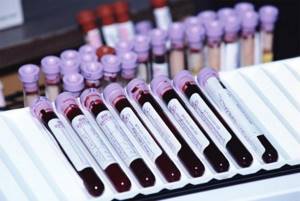
- in case of recurring infectious diseases;
- if the infectious disease is severe and protracted;
- if you suspect congenital or acquired immunodeficiency;
- if an autoimmune disease is suspected;
- for allergic reactions;
- before major surgical interventions;
- if the postoperative period occurs with complications;
- in order to monitor the progress of treatment with certain groups of medications (immunosuppressants, immunomodulators, etc.).
Ig G - interpretation of the test for antibodies to coronavirus
To determine class G immunoglobulins in the blood, a qualitative and quantitative method for determining antibodies is used. Below is a table with a breakdown of the enzyme immunoassay for coronavirus (igG indicator for coronavirus).
Coronavirus antibody index - transcript of captions
| Result | Index | Meaning |
| Negative | Less than 0.8 | The patient either did not encounter the disease or underwent the procedure in the acute phase. |
| Border | 0,8-1,1 | You need to do a repeat test after 14 days. Perhaps the test was done at the onset of the disease or during the recovery process. |
| Positive | More than 1.1 | This level of antibodies to coronavirus in adults is normal. The person had coronavirus infection several months ago, and humoral immunity had time to develop. |
Class G antibodies to coronavirus - interpretation of results
An antibody titer to coronavirus of 1,800 (positive result) is normal. In this case, immunoglobulins of class A and M should be absent in the blood. Their presence indicates the stage of recovery.
Schedule for taking tests and issuing results
Reception of tests and parcels:
- Mon—Thu, 8:30 a.m. to 3:00 p.m.;
- Fri and pre-holidays, from 8:30 to 14:00.
Output of results:
- Mon—Thu, 8:30 a.m. to 4:45 p.m.;
- Fri and pre-holidays, from 8:30 to 15:30.
Readiness of analysis - 10 working days.
Tel. unified help desk: +7 (800) 775-05-82,.
Laboratory email:
Requirements for collecting samples for immunochemical analysis
Blood is taken on an empty stomach in a volume of 8 ml into a test tube to obtain serum (a test tube with blood clotting activators, not EDTA, not heparin). You should not eat food approximately 6-10 hours before the test; you can drink water.
Urine must be collected within 24 hours with normal drinking regimen. At the same time, store the jar of urine in a cool place. In the morning at 6-8 o'clock, empty the bladder (this portion of urine is poured out). Then, during the day, collect all the urine in a clean container with a capacity of at least 2 liters. The last portion is taken exactly at the same time when the collection began the day before (at 6-8 hours). Measure the amount of daily urine using a measuring cup, pour 10-50 ml into a clean plastic container and deliver to the laboratory of the National Medical Research Center for Hematology. Be sure to indicate the volume of daily urine.
When sending samples by mail or courier, you need to know that blood serum in a volume of 2-4 ml is sent for immunochemical analysis (whole blood cannot be sent!) and urine in a volume of 10 ml (from the daily volume indicating the daily amount of urine). All samples must be signed and delivered in a plastic vial or tube with a securely fitting cap. When the bottle is tipped over, the cap should remain in place and the liquid should not spill out through the gaps between the cap and the neck of the container. The time from blood collection to delivery to the laboratory of the National Medical Research Center for Hematology should not exceed 2 days; shipment is carried out at a temperature of +4°...+10°C in special thermal containers.
Necessary documents for the study
A referral from a doctor is required for testing.
Analyzes on a paid (commercial) basis are accepted only with a referral containing the following information:
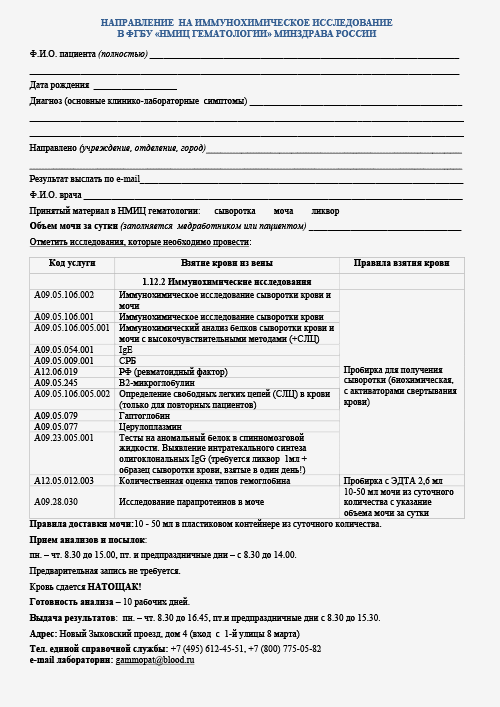
When paying for medical services by bank transfer and sending biomaterial to the National Medical Research Center for Hematology for laboratory research, in addition to this direction, you must attach the following accompanying documents:
- contract for paid medical services;
- informed voluntary consent to receive paid medical services and processing of personal data.
In the absence of these documents, analyzes cannot be done.
BAU/ml - new interpretation of the test for antibodies to coronavirus
The World Health Organization has approved a new international standard for the determination of immunoglobulins for coronavirus, with the unit of measurement BAU (translated as “binding antibody coefficient”).
Interpretation of quantitative analysis for antibodies to coronavirus
Laboratory diagnostics of the level of immunity protection against coronavirus is carried out by studying immunoglobulins to the S protein of the virus. To facilitate the interpretation of the study results, it was proposed to use a universal measurement system.
Conversion table for antibody test results from different manufacturers in BAU/ml
| Manufacturer | Conversion factor to BAU/ml |
| Abbott ARCHITECT | 0,142 |
| Roche | 1 |
Immunochemical blood tests
Immunochemical research allows you to determine the level of hormones, antibodies, biologically active molecules, including for the diagnosis and control of anemia, thyroid diseases, and endocrinological disorders. For this purpose, our laboratory uses a fully automated Cobas e411, Roche system.
The Cobas e 411 analyzer uses modern electrochemiluminescence technology, which provides test results with the highest accuracy, specificity and reproducibility. This provides significant benefits to our patients, namely:
- very short analysis time - 18 minutes for one test - which allows, in an emergency, to obtain a complete test result within an hour.
- wide boundaries for measuring parameters - the range of obtained values is very large: from minimal concentrations of hormones, antibodies and other immunochemical parameters to extremely high ones. This allows for the most reliable diagnosis and monitoring of the therapy used.
- small amount of sample for testing - a very small amount of serum or plasma is required to perform a wide panel of tests. It is possible to take capillary blood (from a finger) if it is necessary to measure single indicators. This is especially important in pediatric practice, when it is necessary to take blood from children, including newborns.
Test material:
- Serum
- Blood plasma
- Saliva
- Urine
Defined indicators:
Laboratory assessment of hormonal regulation of calcium and phosphorus metabolism
- Parathyroid hormone
Laboratory assessment of metabolic imbalance in bone tissue (diagnosis of osteoporosis)
- b-CrossLaps/serum (type 1 collagen fragments in serum)
- Total P1NP (bone matrix formation marker)
- Osteocalcin
- Vitamin D
Laboratory assessment of hormonal regulation of reproductive system function
- Follicle stimulating hormone (FSH)
- Luteinizing hormone (LH)
- Prolactin
- Estadiol
- Progesterone
- Testosterone
- Sex hormone binding globulin (SHBG)
- Dehydroepiandrosterone sulfate
Laboratory assessment of endocrine pancreatic function and diagnosis of diabetes:
- Insulin
- C-peptide
Laboratory assessment of the pituitary-adrenal axis:
- Cortisol
- Adrenocorticotropic hormone (ACTH)
Laboratory assessment of thyroid function:
- Thyroid stimulating hormone (TSH)
- Free triiodothyronine (FT3)
- Free thyroxine (FT4)
- Antibodies to thyroid peroxidase (Anti TPO)
- Antibodies to thyreglobulin (Anti TG)
Laboratory diagnosis of anemia:
- Ferritin
- Folic acid
- Vitamin B12 (cyanocobalamin)
To determine a number of indicators, the phase of the menstrual cycle in women (FSH, LH, prolactin, progesterone, estradiol) and time of day (cortisol) are important, so before the study you should definitely check with your doctor about the optimal time for taking a sample.
